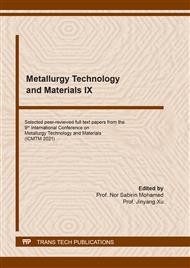p.33
p.39
p.45
p.51
p.61
p.71
p.77
p.85
p.91
Numerical Analysis of Nucleation and Growth of Stray Grain Formation during Laser Welding Nickel-Based Single-Crystal Superalloy Part II: Solidification Cracking Diminution through Single-Crystallinity Control
Abstract:
The effect of thermo-metallurgical factors, such as heat input and welding configuration, on solidification cracking driving forces nearby dendrite tip, such as solidification temperature range and columnar/equiaxed transition (CET) was thermodynamically and kinetically discussed with aid of comprehensive numerical analysis for multicomponent melt-pool solidification during laser processing under non-equilibrium solidification conditions to better understand problematical solidification cracking phenomena. By using (001)/[100] welding configuration, axisymmetrical distributions of columnar/equiaxed transition and solidification temperature range alongside solidification interface are homogeneously produced on both sides of weld pool. By using (001)/[110] welding configuration, nonaxisymmetrical distributions are heterogeneously produced, and are able to bring about infelicitous microstructure degradation. Unidirectional region of [001] columnar dendrite is more prone to epitaxial growth without morphology transition to conservatively better crystallography-assisted single-crystal growth. Unidirectional epitaxial growth is collapsed, and onset of stray grain nucleation and solidification cracking eventuates in [100] region of equiaxed dendrite growth. Low heat input relatively broadens portion of unidirectional columnar dendrite, where stray grain is infrequently nucleated and grown, and thus morphology transition seldom happens, as long as undercooling and solidification temperature range alongside dendrite tip are sufficient low to challengingly develop crackless dendrite growth and high-quality weld by thermometallurgy-aided single-crystallinity control. Auspicious (001)/[100] welding configuration simultaneously abates overall stray grain nucleation and constricts solidification temperature range nearby fusion boundary to wane microstructure heterogeneity. Conversely, plenteous stray grain formation is kinetically attained and extensive solidification temperature range nearby fusion boundary is thermodynamically obtained by problematical (001)/[110] welding configuration to metallurgically induce pernicious equiaxed dendrite and disintegrate dendrite growth. Moreover, the mechanism of solidification cracking diminution as consequence of appropriate optimization of thermo-metallurgical determinants during multicomponent nickel-based single-crystal superalloy melt-pool non-equilibrium solidification is also proposed. The potent consistency between the predicted and experimented results is exceedingly tenable.
Info:
Periodical:
Pages:
61-70
Citation:
Online since:
April 2022
Authors:
Price:
Сopyright:
© 2022 Trans Tech Publications Ltd. All Rights Reserved
Share:
Citation:


